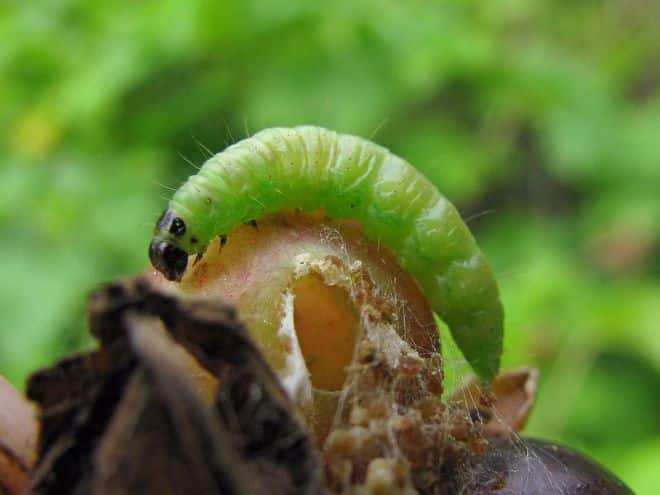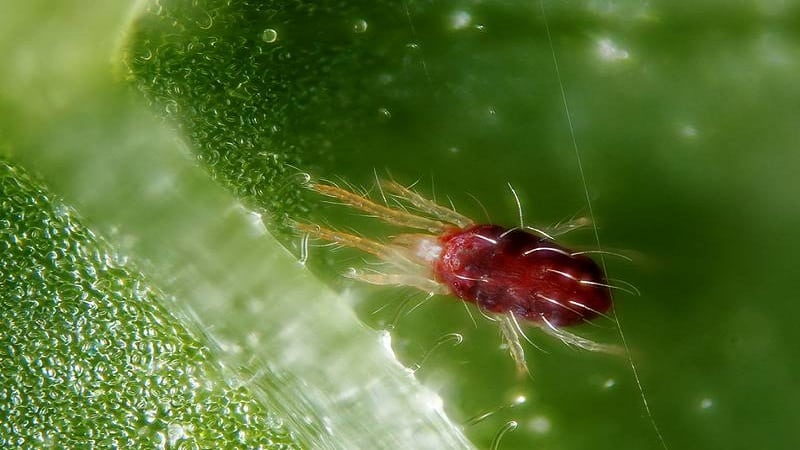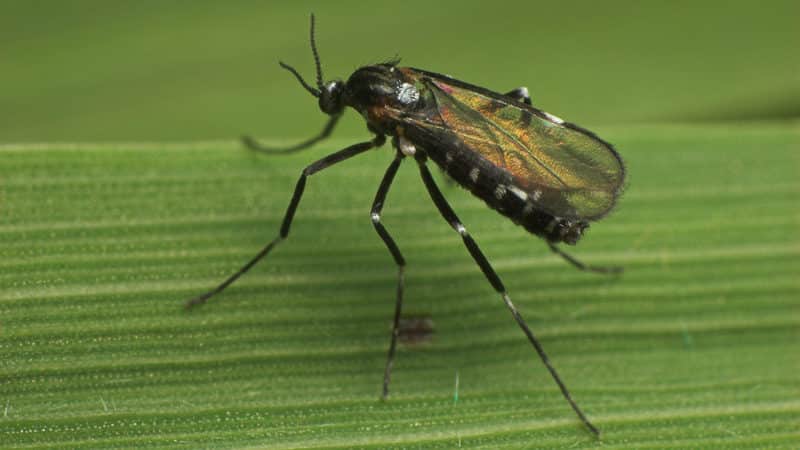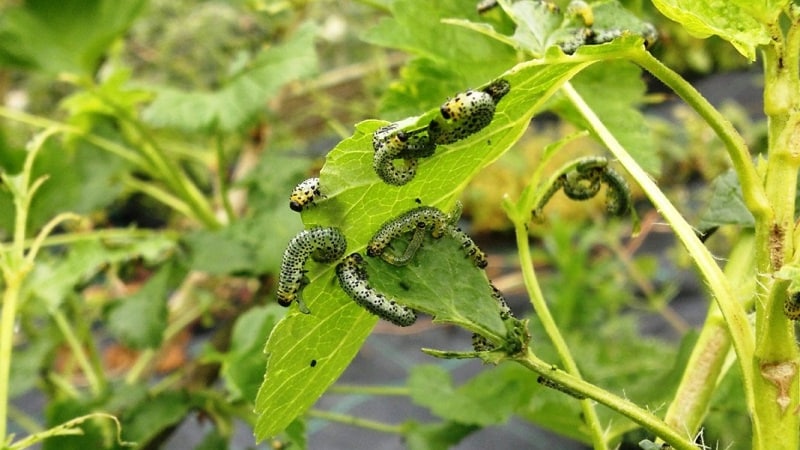Who eats gooseberries and how to deal with pests
Fruit and berry bushes often become the target of attack by insect pests that feed on green foliage, shoots, bark, ovaries and fruits. Gooseberry bushes are no exception. The most dangerous crop pest is the gooseberry moth, which lays eggs in flower ovaries. Worms in gooseberries are caterpillars that feed on the pulp and seeds. In addition to the moth, the plant is attacked by the currant gall midge, which can be recognized by growths on the leaves.
How to deal with gooseberry pests, prevent the spread and completely remove them from the site, what to do if it’s time to harvest, read the article.
Who eats gooseberries

Gooseberry bushes are most often attacked peststhat feed on leaves, young shoots and bark: aphid, spider mite, borer, glass beetle, elm leaf beetle.
The larvae of the most insidious pest of fruit and berry bushes, the gooseberry moth, love to feast on juicy berries. This is a gray, inconspicuous butterfly. On its front wings there are transverse brownish stripes. The green caterpillars with a black head reach 2 cm in length.

The moth becomes active in the spring when the leaves bloom. The pupae overwinter in the ground, and with the onset of warmth, butterflies fly out of them and lay eggs inside the flower ovaries.
Larvae, similar to worms, live right in maturing berries, feed on pulp and seeds. Subsequently, the damaged fruits turn red ahead of schedule, then are rotting and dry.
Affected berries fall off or remain on the bush, entangled in a thick web. One adult caterpillar can destroy 10-15 fruits, so without timely intervention, you can completely lose the harvest.
Reference. From the eggs of the gooseberry moth, after 1-1.5 weeks, caterpillars emerge, which eat up the contents of the ovaries within a month.
The currant gall midge most often attacks currant bushes, but it does not mind profiting from juicy leaves, flower ovaries and gooseberry fruits. The pest larvae mature in leaves, shoots, flowers, berries and hide in chambers called galls. These shelters resemble growths. The adult gall midge resembles a small two-winged mosquito.

How to control pests
To combat the gooseberry moth and currant gall midge, they use the method of manual collection, agrotechnical methods, folk and chemical remedies, and also collect the affected plant parts and burn them away from the site.
Agrotechnical techniques

Moth caterpillars grow, fall to the ground and hibernate there until spring. The pest does not go far from its feeder and hides under gooseberry bushes.
In the fall, gardeners dig up the ground with a pitchfork so that the pupae end up on the surface and freeze in winter.
In the spring, the area is mulched with roofing felt, roofing felt, thick black film or agrofibre. The tree trunk circles are covered with roofing felt to prevent the flight of butterflies. The technique will be repeated from year to year until the moth completely disappears from the area.
In early spring, gooseberry bushes are hilled to a height of 10-15 cm and removed after flowering. Insects are not able to overcome such an obstacle, so they die.
Butterfly traps made from plastic bottles are hung on the bushes.Windows are cut into them and filled 1/3 with fermented juice, kvass or beer. If you leave the bowls on the ground, slugs will gather in them.
Hand picking of infected berries also helps to get rid of moth worms. The caterpillars are collected from the bushes into an old container and destroyed.
To repel gall midges, mint, marigolds, decorative tansy, geranium, delphinium, Dalmatian chamomile, pyrethrum, nasturtium, calendula, and lavender are planted next to gooseberries.
How to treat the bushes and is it possible to eat the berries after that?
Fighting the gooseberry moth is a difficult task, but it is doable if you follow the recommendations of experienced gardeners and act consistently. Caterpillars crawl out of berries when they are exposed to chemicals.
To treat gooseberry bushes, biological products are used 2 times a week every 7 days: “Gomelin”, “Dendrobacillin”, “Lepidotsid”, “Entobacterin”, “Bitoxibacillin”. The products are safe for humans and the environment, so they are allowed to be used during fruit set.
Treatment with chemicals is carried out at the moment of bud break and immediately after flowering.
Such drugs are effective: “Aktellik”, “Fufanon”, “Senpai”, “Kinmiks”, “Karbofos”, “Iskra-M”, “Iskra”, “Gardona”. After treatment, wait 2-3 weeks before harvesting begins.
Folk remedies alternate with chemical treatment for greater effectiveness or are used only during the period of fruit formation.
Traditional recipes:
- A 10 liter bucket is filled 1/3 with ash and water is poured to the top. The mixture is stirred and infused for 48 hours, then filtered through cheesecloth and the bushes and tree trunks are thoroughly processed.
- 100 g of mustard powder is poured into 10 liters of boiling water and left for 48 hours. Then the mixture is diluted with cold water 1:1.Bushes and tree trunks are treated in the evening or in cloudy weather.
- 4 kg of tomato tops are poured into 10 liters of water and boiled over low heat for 30 minutes. Then the broth is cooled to room temperature and diluted with water 1:4. Treatment is performed 2-3 times every 5-7 days.
- 1 kg of tobacco shag is poured into 10 liters of water and left for 24 hours. Before processing, 40 g of soap shavings are mixed into the solution for better adhesion. The treatment is performed twice with an interval of 7 days.
- 100 g of dry chamomile is poured into 10 liters of boiling water, left for 10-12 hours, filtered and sprayed on the bushes during the flowering period.
- 200 g of pine or spruce needles are poured into 2 liters of boiling water and left for 7 days in a closed container, stirring the infusion daily. Before treatment, the product is diluted with water 1:10. With an average degree of infection, 2-3 sprayings with an interval of 7 days are sufficient.
The success of gooseberry pest control depends entirely on the efforts of the gardener. To prevent the spread of insects, the area is mulched, covered with agrofibre, the plantings are periodically thinned, pruning is carried out in a timely manner, seedlings are fed with organic matter and minerals, and repellent flowers are planted nearby.
Conclusion
The gooseberry moth is an inconspicuous gray butterfly whose caterpillars can completely deprive a gardener of his harvest. The larvae feed on pulp and seeds, then fall to the ground, pupate and overwinter there until spring. The currant gall midge often attacks currants, but does not mind profiting from gooseberries. The pest larvae mature in leaves, shoots, flowers, berries and hide in chambers called galls.
Pest control is carried out using agrotechnical techniques (hilling up, mulching, covering the tree trunk circle with film and roofing material).To treat bushes, chemicals are used (“Aktellik”, “Fufanon”, “Kinmiks”, “Karbofos”, “Iskra-M”, “Iskra”, “Gardona”) and biological products (“Gomelin”, “Dendrobacillin”, “Lepidotsid” ", "Entobacterin", "Bitoxibacillin"). Folk remedies based on ash, chamomile, mustard, pine needles, tomato tops, and tobacco shag alternate with chemicals for greater effectiveness.